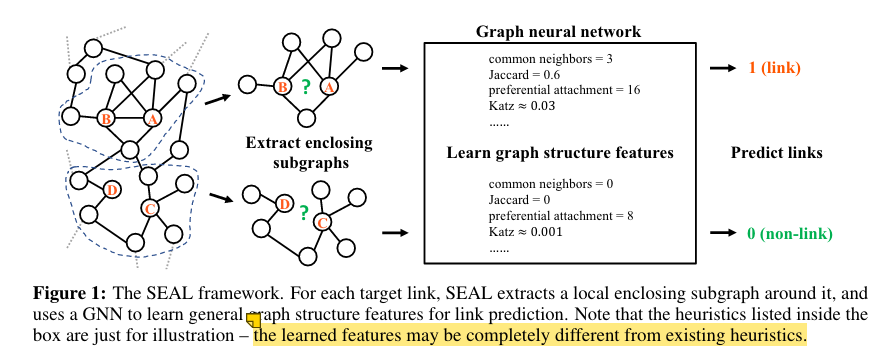Link Prediction Based on Graph Neural Networks
第一作者:Muhan Zhang, Yixin Chen
作者单位:Washington University
发表时间:2018
发表期刊:NeurIPS 2018
关键内容:提出了一种图链接预测启发式算法 \(\gamma\)-decaying heuristic,并提出了SEAL(learning from Subgraphs, Embeddings and Attributes for Link prediction)预测框架.

1. 引言
- enclosing subgraph: The enclosing subgraph for a node pair (x, y) is the subgraph induced from the network by the union of x and y’s neighbors up to h hops.
常用的链接预测启发式算法:Katz, rooted PageRank and SimRank.
Katz index: 给邻居节点赋予不同的权重, 对于短路径赋予较大的权重, 而长路径赋予较小的权重。
PageRank: 入链: in-links。出链: out-links。
SimRank: 一种用于衡量结构上下文中个体相似度的方法,其基本思想是:如果两个对象a和b分别与另外两个对象c和d关联,且已知c与d是相似的,则a与b也是相似的;并且任意节点与其自身拥有最大的相似度值为1。
\(\gamma\)-decaying heuristic: 论文中进行了详细推导。并且证明了Katz, rooted PageRank and SimRank 作为 \(\gamma\)-decaying heuristic 的特殊形式。

2. SEAL: An implemetation of the theory using GNN
SEAL framework : 1)enclosing subgraph extraction, 2)node information matrix construction(each row of matrix corresponds to a node’s feature vector, three components: structural node labels, node embeddings, node attributes), 3)GNN learning.
structural node labels: A node labeling is function fl : V -> N which assigns an integer label \(f_l(i)\) to every node i in the enclosing subgraph. The purpose is to use different labels to mark nodes’ different roles in an enclosing subgraph. 具体方法是Double-Radius Node Labeling (DRNL).
node embeddings: 加入负样本进行嵌入。
3. Experimental results


4. References
Zhang M, Chen Y. Link prediction based on graph neural networks[J]. Advances in neural information processing systems, 2018, 31.
